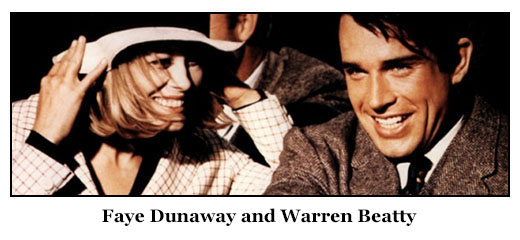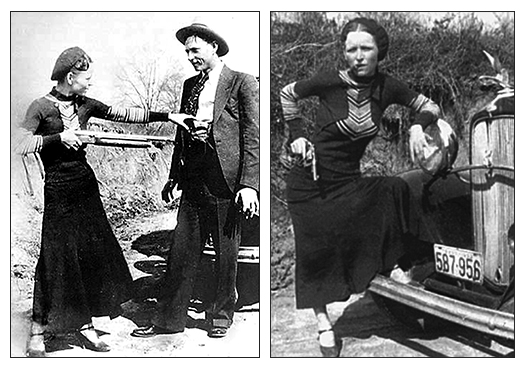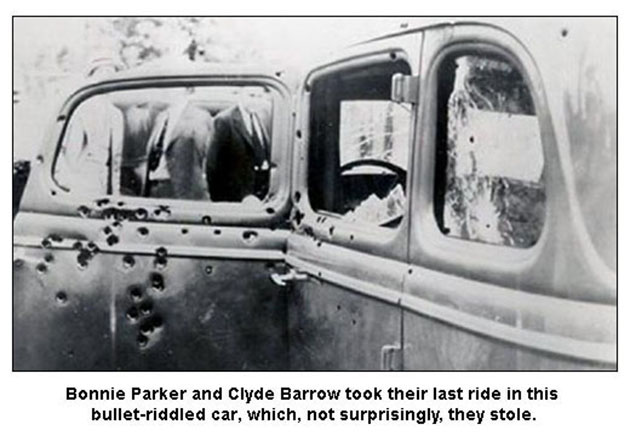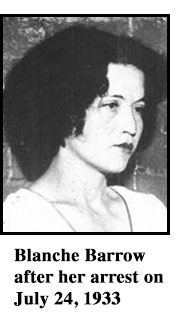| HOME • FAMILY • YESTERDAY • SOLVAY • STARSTRUCK • MIXED BAG |
 |
 |
Clyde Barrow (who looks like a Vulcan in an early mug shot, above) is best remembered today as the crime partner of Bonnie Parker. However, during his erratic and violent crime spree — from February, 1932, to his death in May, 1934 —he was either identified as one of the bloody Barrow brothers, or as a desperado and wanted killer. Newspaper stories mentioned he traveled with a cigar-smoking gun moll, but her name didn't necessarily appear in the story. The thing is, Bonnie Parker didn't actually smoke cigars. She stuck one in her mouth for what almost certainly was a gag photograph that inadvertently fell into the hands of police, who made it available to the press. Even after there was evidence Ms. Parker chain-smoked only cigarettes and had asked at least two men to spread the word she did not smoke cigars, the press refused to let facts interfere with their colorful description of the outlaw. (Those two men were among the several people abducted by Bonnie and Clyde, then released a few hours later.) AS FOR Marvin (Buck) Barrow, he was a criminal a lot longer than brother Clyde, who was six years younger, but Buck's reputation wasn't known beyond parts of Texas until he made the mistake of throwing away a golden opportunity to go straight. In 1931, more than a year after he had escaped from prison, he voluntarily turned himself in. His wife, Blanche, and his family had talked him into it, and, on March 22, 1933, when Buck was pardoned by Texas Governor Miriam"Ma" Ferguson, Blanche was hopeful she and her husband would lead a normal life. Unfortunately for Blanche, Buck's brother Clyde was on a rampage. The Barrows had always been penny ante robbers — starting with chickens and turkeys — though mostly at first they stole automobiles and sold them to shady dealers. BUT WHILE Buck was in prison, Clyde added a new crime to his resume — murder. By the time Buck foolishly agreed to rejoin Clyde, supposedly for a little rest and recreation in Joplin, Missouri, the younger Barrow brother was wanted for five murders. Buck paid the ultimate price for his foolishness, and was fatally wounded in a shootout near Dexter, Iowa, on July 20, 1933. He and wife Blanche were captured four days later, and on July 27, Buck passed away. Clyde Barrow would remain a failure as a robber, partly because he thought small, sticking up places that didn't have much money, including the dozen or so banks on his record. I found estimated loot from seven Barrow bank jobs. The total was $11,598, and that usually was split at least three ways. By contrast, in 1934, after John Dillinger was gunned down by federal cops, the Associated Press published what they labeled the outlaw's "financial report" — 13 bank robberies that netted the Dillinger gang $302,739. So Clyde Barrow was strictly a bush league bank robber. As for Bonnie Parker, she almost always sat in the car while Clyde and and his partners — who included, at various times, Raymond Hamilton, Ralph Fults, Joe Palmer and Henry Methvin — entered the banks. WERE IT NOT for a few photographs of Bonnie Parker and her attempts at poetry, she and the Barrow boys might be forgotten today. Even then, they were barely above the radar until 1967 when Faye Dunaway and Warren Beatty brought Bonnie and Clyde back to life in a movie that clicked with the public. Bonnie Parker's name had been used in two previous films, but the first, "Public Enemies" (1941), made her a screwball heiress played by Wendy Barrie, and in the second, "The Bonnie Parker Story" (1958), she was machine gun-toting gangster played by Dorothy Provine, but the name of her partner was Guy Darrow, played by Jack Hogan. NEEDLESS to say, the Dorothy Provine film did nothing to promote the legend that grew out of the 1967 film. That one caught on so well, in part, because it was one of the few serious, big-budget attempts to look at Depression-era outlaws. "Pretty Boy" Floyd, "Baby Face" Nelson and "Machine Gun" Kelly were featured in films, but most of them were low-budget, exploitation productions.
Gene Hackman, one of our best actors, was cast as Buck, and Estelle Parsons would win an Oscar in her role as Blanche. Actually, Dunaway would have been better cast as Blanche Barrow, who was badly served by Parsons' performance. John Neal Phillips, who interviewed Blanche Barrow for his book, "Running With Bonnie and Clyde: The Ten Fast Years of Ralph Fults," said she told him, "That movie made me look like a screaming horse's ass." THE FILM did what many movies have done, it created composite characters for the purpose of simplification. Some of the things attributed to Blanche were actually done by a woman named Mary O'Dare, the girl friend of Raymond Hamilton, a sometime-member of the Barrow gang. Mary O'Dare and Hamilton, in my mind, are a more interesting duo than Bonnie and Clyde, but neither is present in the movie, which also merged teenager W. D. Jones and an older outlaw, Henry Methvin, into a fictitious character called C. W. Moss (Michael J. Pollard), and did such a great disservice to Jones, that he attempted to sue the filmmakers. That disservice was making it appear that Jones had double-crossed Clyde Barrow, setting him up to be killed, when that actually was the work of Methvin. Jones and Blanche Barrow were among the few people who had run with the Barrow gang and lived long enough to see the movie. So did Mary O'Dare, but she was probably grateful to be left out of it. |
 |
DUNAWAY and Beatty were a bit too old for the parts they played, and much too big. Beatty, at six-feet-two-inches, is eight inches taller than the real Clyde Barrow, a relatively slight individual. Dunaway is five-foot-seven-inches tall, while Bonnie Parker was about four-feet-eleven and very thin. Physically, the best two actors for the film, had it been made in the early 1940s, would have been Veronica Lake (four-foot-eleven) and Alan Ladd (five-feet-six). Mickey Rooney (at five-foot-two) would have been well cast as Ray Hamilton, who was only an inch taller. As mentioned, Bonnie Parker carried a false reputation that grew out of an undeveloped roll of film she and Barrow left behind when they were chased from a hideout in Joplin, Missouri, in April, 1933. When the photographs were developed and printed in newspapers, Bonnie Parker became known as a cigar-smoking gun moll who was a crack shot. Two of those photographs were particularly memorable: |
 |
IT'S FUNNY how people appear in old photos. The Bonnie Parker holding a gun on Clyde Barrow (above, left) could believably be described as his grandmother. She looks better in the photo on the right, but that one came back to haunt her because of the cigar stub. Much has been written about Bonnie and Clyde, and a lot of it undoubtedly is false. I had not intended to delve this deeply into the lives of two truly despicable people, but I was stunned by the amount of material available online, and the apparent devotion of those who maintain Bonnie and Clyde websites. Also, I recently watched a tale about Bonnie and Clyde on PBS's "American Experience," a fine series. But I didn't put much stock in many of the things said by descendants of the Barrow family, particularly that Clyde Barrow felt bad about killing people, claiming it was always in self-defense, which simply was not true. THIS DOCUMENTARY also regurgitated that nonsense about life being so bleak during the Depression that people (1) rooted for outlaws who robbed banks and (2) followed their exploits because there wasn't much else happening. Clyde Barrow killed people who didn't willingly give up their cars or the goods they sold at their stores or because they were wearing a badge. The banks he robbed were hanging by a thread. Nothing in the press at the time made him out to be heroic, and Bonnie Parker was usually referred to simply as his cigar-smoking gun moll. To be aware of Barrow and Parker, a person had to read the newspaper. But a person who read the newspaper would have been aware of many people and things that were more interesting, because 1933 was one of the most newsworthy years in American history. There was no shortage of women in the news, even for those only interested in murders and robberies. Accused in the juiciest murder trial of the year was Jessie Costello, a young Massachusetts widow and mother. At the heart of one of 1933's weirdest cases was 62-year-old Dr. Alice Lindsay Wynekoop, who killed her daughter-in-law. And one of the most unbelievable murders was committed in Hastings-on-Hudson, New York, by a 13-year-old girl. Bonnie Parker's adventures paled by comparison with what Eloise Wehrborn de Wagner-Bousquet was up to in the Galopagos, and the ongoing soap opera-mystery involving singer and stage actress Libby Holman. The most glamorous gun moll of the year was Eleanor Jarman, who went on to become a real-life fugitive, a la Richard Kimble, but she remained missing until the end. And if you were looking for heroic women, there was no shortage, starting with Eleanor Roosevelt, our new (and very different) first lady. Making headlines throughout the year was Anne Morrow Lindbergh, bouncing back from the unspeakable tragedy of her son's kidnapping and murder in 1932, and accompanying her famous husband, Charles Lindbergh, on an incredible series of flights. Also on the scene: Amelia Earhart. I have to believe that in 1933, and even up to their deaths in 1934, Bonnie Parker and Clyde Barrow were small potatoes. (It was much bigger news in '34 when John Dillinger and Pretty Boy Floyd were killed.) But there is no doubt Bonnie and Clyde rule today. |
 |
| HOME • CONTACT |
 But "Bonnie and Clyde" was well-mounted, if miscast and misleading. Beatty was considered a major star, and Dunaway would soon be so regarded.
But "Bonnie and Clyde" was well-mounted, if miscast and misleading. Beatty was considered a major star, and Dunaway would soon be so regarded.